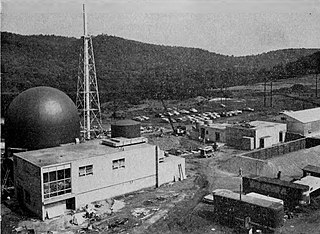
Solar energy is radiant light and heat from the Sun that is harnessed using a range of technologies such as solar power to generate electricity, solar thermal energy, and solar architecture. It is an essential source of renewable energy, and its technologies are broadly characterized as either passive solar or active solar depending on how they capture and distribute solar energy or convert it into solar power. Active solar techniques include the use of photovoltaic systems, concentrated solar power, and solar water heating to harness the energy. Passive solar techniques include orienting a building to the Sun, selecting materials with favorable thermal mass or light-dispersing properties, and designing spaces that naturally circulate air.

Ocean Thermal Energy Conversion (OTEC) uses the ocean thermal gradient between cooler deep and warmer shallow or surface seawaters to run a heat engine and produce useful work, usually in the form of electricity. OTEC can operate with a very high capacity factor and so can operate in base load mode.

Solar thermal energy (STE) is a form of energy and a technology for harnessing solar energy to generate thermal energy for use in industry, and in the residential and commercial sectors.

A solar thermal collector collects heat by absorbing sunlight. The term "solar collector" commonly refers to a device for solar hot water heating, but may refer to large power generating installations such as solar parabolic troughs and solar towers or non water heating devices such as solar cooker, solar air heaters.

Thermal energy storage (TES) is achieved with widely different technologies. Depending on the specific technology, it allows excess thermal energy to be stored and used hours, days, months later, at scales ranging from the individual process, building, multiuser-building, district, town, or region. Usage examples are the balancing of energy demand between daytime and nighttime, storing summer heat for winter heating, or winter cold for summer air conditioning. Storage media include water or ice-slush tanks, masses of native earth or bedrock accessed with heat exchangers by means of boreholes, deep aquifers contained between impermeable strata; shallow, lined pits filled with gravel and water and insulated at the top, as well as eutectic solutions and phase-change materials.
The Westinghouse Astronuclear Laboratory (WANL) was a division of Westinghouse Electric Corporation. Established in 1959 to develop nuclear space propulsion technologies for the government, the lab was located, for most of its history, in the paradoxically small town of "Large" along Pa. Rte 51, about 13 miles (21 km) south of Pittsburgh in Allegheny County, Pennsylvania, USA. The site is not far from the Bettis Atomic Power Laboratory in West Mifflin, which Westinghouse operated during the same time and later.

The Saxton Nuclear Experiment Station, also known as the Saxton Nuclear Generating Station or Saxton Nuclear Experimental Corporation Facility, was a small nuclear power plant located in Bedford County, near Saxton, Pennsylvania.

The Georgia Power Company Corporate Headquarters is a 24-story, 91 m (299 ft) skyscraper in downtown Atlanta, Georgia serving Georgia Power, a subsidiary of Southern Company. The prior Georgia Power headquarters building was in downtown Atlanta at the corner of Alabama and Forsyth streets in the former Atlanta Constitution Building.
Solar air conditioning, or "solar-powered air conditioning", refers to any air conditioning (cooling) system that uses solar power.
The Westinghouse Combustion Turbine Systems Division (CTSD), part of Westinghouse Electric Corporation's Westinghouse Power Generation group, was originally located, along with the Steam Turbine Division (STD), in a major industrial manufacturing complex, referred to as the South Philadelphia Works, in Lester, PA near to the Philadelphia International Airport.
Westinghouse Advanced Energy Systems Division (AESD) was a research and development facility for nonconventional renewable energy systems, in the small town of Large in Allegheny County, Pennsylvania [USA]. The site is on the east side of Pa. Rte. 51, about 13 miles (21 km) south of Pittsburgh. Formerly the site of the Westinghouse Astronuclear Laboratory (WANL), Westinghouse Electric Corporation changed the name of the facility, along with its charter, in 1977.
Sopogy was a solar thermal technology supplier founded in 2002 at the Honolulu, Hawaii-based clean technology incubator known as Energy Laboratories. The company began its research on concentrating solar thermal energy to produce solar steam and thermal heat for absorption chillers or industrial process heat. The company has also developed applications that incorporate its solar collectors to generate electricity and desalination. Sopogy's name origin comes from industry key words "So" from solar "po" from power and "gy" from energy and technology. The company has its OEM and IPP sales teams along with research and development located in Honolulu, and in 2006 expanded its manufacturing, C&I and oil and gas sales teams in its Silicon Valley facility. Pacific Business News and Greentech Media reported that the VC-funded micro-concentrator solar power firm was shutting down operations based on statements from its President David Fernandez, however Hitachi Power Systems acquired Sopogy in a private transaction in 2014.

Concentrated solar power systems generate solar power by using mirrors or lenses to concentrate a large area of sunlight into a receiver. Electricity is generated when the concentrated light is converted to heat, which drives a heat engine connected to an electrical power generator or powers a thermochemical reaction.

A solar power tower, also known as 'central tower' power plant or 'heliostat' power plant, is a type of solar furnace using a tower to receive focused sunlight. It uses an array of flat, movable mirrors to focus the sun's rays upon a collector tower. Concentrating Solar Power (CSP) systems are seen as one viable solution for renewable, pollution-free energy.

eSolar is a privately held company that develops concentrating solar power (CSP) plant technology. The company was founded by the Pasadena-based business incubator Idealab in 2007 as a developer of CSP plant technology. The company aims to develop a low cost alternative to fossil fuels through a combination of small heliostats, modular architecture, and a high-precision sun-tracking system. In October 2017, an article in GreenTech Media suggested that eSolar ceased business in late 2016.

Sierra SunTower was a 5 MW commercial concentrating solar power (CSP) plant built and operated by eSolar. The plant is located in Lancaster, California. As of mid-September, 2022, the two towers that were the center of the facility are no longer standing. However the rest of the plant is still present.
Areva Solar was part of the renewable energies portfolio of the French nuclear group Areva, headquartered in Mountain View, California, with offices in the United States and Australia. It designed, manufactured and installed solar steam generators for electric power production and industrial steam uses. Before 2010, the company existed as Ausra Inc. In August 2014, AREVA announced it was shuttering AREVA Solar.

Renewable energy sources such as solar, wind, tidal, hydro, biomass, and geothermal have become significant sectors of the energy market. The rapid growth of these sources in the 21st century has been prompted by increasing costs of fossil fuels as well as their environmental impact issues that significantly lowered their use.
The TR-2 nuclear reactor, also known as the Westinghouse Test Reactor or Westinghouse Testing Reactor (WTR) was a small research and test reactor designed and manufactured by Westinghouse Electric Corporation at their Waltz Mill site near Madison, Pennsylvania, approximately 30 miles southeast of Pittsburgh. TR-2 was the first privately owned research and test reactor. The reactor suffered an accident which involved severe fuel damage in 1960.












